When to feed baby food twice a day
Feeding your baby: When to start with solid foods
Up to 6 months old
From the first hour of life, through to 6 months old, your baby can receive all of the nutrition she needs to grow and develop from your milk. She doesn’t need anything else – no water, tea, juice, porridge or any other foods or fluids during this period.
Myth: Babies need solid food sooner than 6 months old
When you breastfeed your baby frequently, starting foods earlier than 6 months is not necessary and can even be harmful.
Introducing foods or fluids other than breastmilk to your baby before she is 6 months old can increase her risk of illnesses, such as diarrhoea, which can make her thin and weak, and even be life-threatening. Your baby may also breastfeed less often, so your supply of milk, her most vital food, may decrease.
A mother’s milk is the safest and healthiest food for the first 6 months of life for all children everywhere. It is a constant, safe source of essential nutrition, wherever you and your baby live in the world.
Feeding signs
If you see your baby with her hands near her mouth when she’s still younger than 6 months, you may think she’s not getting enough to eat from your milk alone. Actually your baby is showing normal feeding signs, they are just more developed now that she’s older. It doesn’t mean your baby needs solid food early. Your baby is ready when she is 6 months old.
Myth: Boys need more than breastmilk
Both baby girls and boys need the same amount of food to be healthy and grow strong and smart. Your milk alone will meet the nutrition needs of both a son or a daughter in these first months of life.
6 months and older
When your baby reaches 6 months, his rapid growth and development require more energy and nutrients than your milk alone can provide. He needs to start eating solid foods in addition to breastmilk to keep up with his growing needs.
When to feed your baby solid foods
Feed your baby whenever you see him give feeding signs. After washing hands with soap, start by giving your baby just two to three spoonfuls of soft food, such as porridge, mashed fruits or vegetables, twice a day. Continue to breastfeed as often as before.
After washing hands with soap, start by giving your baby just two to three spoonfuls of soft food, such as porridge, mashed fruits or vegetables, twice a day. Continue to breastfeed as often as before.
Non-breastfed babies
If you do not breastfeed your baby, the best time to introduce her to solid foods is also at 6 months of age. This is the age when all babies, breastfed or not, need to start getting solid foods to ensure they are getting all the nutrition their growing bodies need.
Living with HIV
If you are living with HIV, introduce your baby to his first solid foods at 6 months and continue to breastfeed him while taking your ARV medicines and following your treatment plan.
Don't wait too long to start solid food
Your baby’s body needs the extra energy and nutrients to help him to keep growing. Waiting too long may cause your baby to stop gaining weight at a healthy rate, and put him at risk of becoming thin and weak.
Balancing introducing solids with milk feeds
At around 6 months of age babies need to start having solid foods as well as breastmilk or formula. Find out how to get started with solid foods and what are the best foods to start with.
Find out how to get started with solid foods and what are the best foods to start with.
When to introduce solids?
At 6 months, your baby will still be getting most of their nutrition from breast milk or formula.
As you introduce solid foods, continue feeding with breastmilk or formula until at least 12 months of age.
Start to introduce solid foods at around 6 months of age when:
- your baby can sit up with support and has good head control
- your baby starts to show interest in food such as watching and reaching out when they see food
Even though some babies show these signs from an earlier age, continue to offer your baby breastmilk or formula if they appear hungry. This is usually all they need until around 6 months. It’s recommended that you don’t introduce solids before 4 months.
How to introduce solid foods into your baby’s diet
Start feeding your baby solids once a day. Your baby will take only small amounts of solid foods at first. Try one teaspoon at first of pureed vegetable, fruit, or rice cereal in between milk feeds.
Try one teaspoon at first of pureed vegetable, fruit, or rice cereal in between milk feeds.
From 6 to 9 months continue to give your baby breastmilk or formula first, then try solids after the milk.
From 9 months you can try to give solids first, then breastmilk or formula. This allows for your baby to naturally transition to solids by around 12 months.
At around 8 to 9 months try giving your baby solids as part of breakfast, lunch, and dinner.
Continue breastmilk or formula through the first year of life while foods are being introduced. From around 6 months you can try small amounts of cooled boiled water out of a sippy cup.
Which foods first?
From 6 months of age baby’s first foods should contain iron. Foods that have iron, include:
- iron-fortified baby cereals
- meat
- poultry
- fish
- legumes - lentils, beans, or chickpeas
Guidelines recommend that you can introduce foods in any order and at a pace that suits your baby, family, and cultural backgrounds, as long as some foods servings contain iron.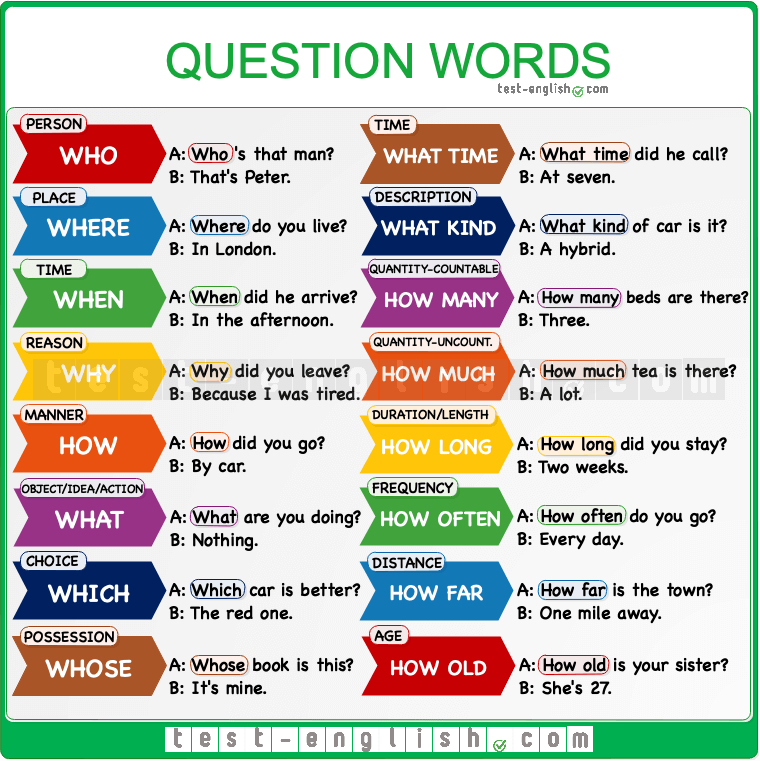
Your baby’s first foods can be smooth, mashed or have soft lumps.
Choose from the 5 food groups.
Vegetables and legumes
Give your baby cooked and pureed:
- pumpkin
- sweet potato
- carrots
- potato
- peas
- broccoli
- cauliflower
- zucchini
Over time puree them less so the texture gets lumpier.
Then introduce vegetables that are cooked but not pureed.
Fruit
Give your baby stewed and pureed:
- apples
- pears
- peaches
- apricots
- berries
Your baby might also like to try mashed ripe banana.
Gradually introduce pieces of cooked fruit, banana, peach and grated raw apple.
Avoid larger pieces of raw apple; babies can choke on them.
Grains and cereals
Give your baby fortified infant cereals (e.g. rice cereal) to start.
Move to cooked rolled oats, wholegrain breakfast biscuits (Weetbix, Vita Brits) or thick infant cereals.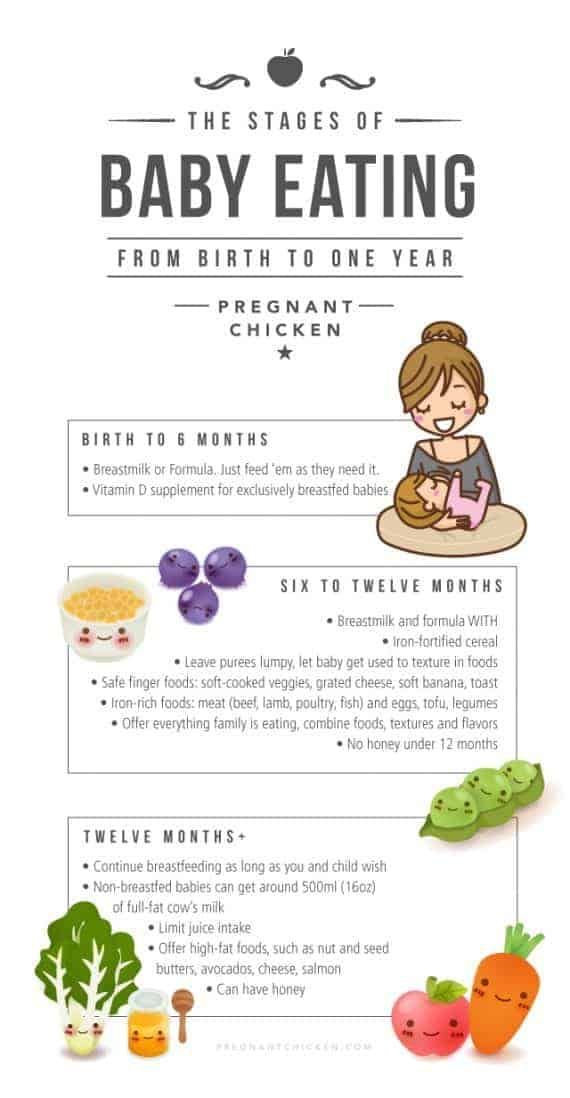
Don’t add sugar or honey or offer cereals with chocolate or added sugar.
Meat, fish, poultry, eggs, legumes, tofu
Meat, fish, poultry eggs, legumes, tofu should always be pureed when you start introducing solids.
When your baby accepts this, offer them bite size pieces of:
- chicken
- minced meat
- flaked fresh or canned fish (in spring water)
- mashed tofu
- mashed legumes
- scrambled or mashed boiled eggs
Don’t add salt. Also avoid processed meats as they have a lot of salt.
Milk, cheese, yoghurt
Formula should be used only until your baby is 12 months old. Then small amounts of milk can be added to foods like porridge. Breast feeding is recommended to continue until the age of 2 or longer.
Grated cheese is good in mashed vegetables.
Choose yoghurt without added sugar. Add fruit for extra flavour
What drinks should I be giving my baby?
After 12 months of age breastmilk, water (clean tap water or bottled water) and full fat cow’s milk should be the main drinks you offer your baby.
Keep breastfeeding for as long as you and your baby like.
Switch from formula to full fat ordinary cow’s milk after 12 months. Your child doesn’t need toddler milk products. Offer your baby a cup to drink from rather than a bottle. Your one-year-old should be exclusively drinking from a toddler cup.
From about 12 months, you can try rice milk and oat milk (fortified with at least 100mg calcium/100mL) if you want. But these drinks don’t have enough protein and vitamin B12. Your baby will need to have plenty of meat, poultry, fish, eggs, yoghurt, or cheese to make up for what they’re not getting from cow’s milk.
How much should I feed my baby?
Your baby will grow at different rates at different times. Their appetite can vary, even from day to day.
Babies don’t know what to eat but they know how much. Provide wholesome, healthy unprocessed food choices. Take your cue from your baby. Babies tend to turn away or lose interest when they’ve had enough to eat.
Finger foods and self-feeding
By 9 to 12 months, most babies like finger foods. Finger foods are foods they can hold themselves.
Some also like to hold their own spoon at that age. It will be messy! But learning to feed themselves is important.
By 12 months, your baby can eat the same healthy food you serve your family.
Foods to limit or avoid when introducing solids
There are some foods and drinks you should limit or avoid:
- coffee and tea, herbal drinks are not recommended
- fruit juice
- honey until 12 months (to prevent botulism)
- processed foods
- raw or runny eggs (bacteria in raw eggs can be harmful to babies)
- sugar sweetened drinks
- unpasteurised milks
Low-fat milks are not recommended in the first 2 years of life. Goat’s milk, sheep’s milk, soy milk, coconut milk and almond milk should also be avoided before the age of 2 unless your doctor recommends them.
Avoid small hard foods such as whole nuts and uncooked vegetables until 3 years. These can be choking hazards.
If your family doesn’t use animal products, your baby may need a vitamin B12 supplement. Discuss this with your doctor.
Seek help from your health care professional if you are worried about your baby’s eating or development.
Fruit — give your baby stewed and pureed apples, pears, peaches, apricots and berries, or mashed ripe banana. Gradually introduce pieces of cooked fruit, banana, peach and grated raw apple. Avoid larger pieces of raw apple; babies can choke on them.
Grains and cereals — give your baby fortified infant cereals (e.g. rice cereal) to start. Move to cooked rolled oats, wholegrain breakfast biscuits (Weetbix, Vita Brits) or thick infant cereals. Don’t add sugar or honey and don’t use cereals with chocolate or added sugar.
Meat, fish, poultry, eggs, legumes, tofu — make them pureed at the start. When your baby accepts this, offer them pieces of chicken, minced meat, flaked fresh or canned fish (in spring water), mashed tofu, mashed legumes, scrambled or mashed boiled eggs. Don’t add salt and avoid processed meats as they also have a lot of salts.
When your baby accepts this, offer them pieces of chicken, minced meat, flaked fresh or canned fish (in spring water), mashed tofu, mashed legumes, scrambled or mashed boiled eggs. Don’t add salt and avoid processed meats as they also have a lot of salts.
Milk, cheese, yoghurt — breast milk or formula should be used for up to 12 months, then small amounts of milk can be added to foods like porridge. Grated cheese is good in mashed vegetables. Choose yoghurt without added sugar. Add fruit for extra flavour.
How much?
Babies grow at different rates at different times. Their appetite can vary even from day to day.
Babies don’t know what to eat but they know how much. Take your cue from your baby. Healthy babies turn away or lose interest when they’ve had enough.
Finger foods and self-feeding
By 9 to 12 months, most babies like finger foods.
Some also like their own spoon at that age. It will be messy, but learning to feed themselves is important.
By 12 months, serve the same healthy food you serve your family, but without hot spices.
Encourage infants to feed themselves.
If you have stopped breastfeeding, switch to ordinary cow’s milk after 12 months. Use a cup rather than a bottle. Limit the amount of cow’s milk to around 500ml per day. Under health professional supervision, you can use full fat rice milk or oat milk with at least 100mg calcium per 100mL if you want, as long as other sources of protein are included (meat, chicken, fish, eggs, legumes or nut butters).
Your child doesn’t need toddler milk products.
If your family doesn’t use animal products, your baby may need a vitamin B12 supplement. Discuss this with your doctor.
Learn more here about the development and quality assurance of healthdirect content.
Union of Pediatricians of Russia
Nutrition for children from 1 to 3 years of age
The period from 1 to 3 years of life is a crucial stage in the transition to an adult type of nutrition, which has certain features. In order to ensure that all the necessary nutrients enter the child's body and at the same time prevent an excess of individual nutrients, nutrition should be balanced and varied. nine0003
In order to ensure that all the necessary nutrients enter the child's body and at the same time prevent an excess of individual nutrients, nutrition should be balanced and varied. nine0003
The daily amount of food for children aged 1 to 1.5 years should be 1000-1200 g, from 1.5 to 3 years - 1200-1500 g, the amount of food in one feeding should not exceed 300-350 ml. The diet consists of three main meals per day and two snacks. It is considered optimal when breakfast is 25% of the total energy density of the diet, lunch is 30–35%, dinner is 20%, and additional meals are about 10%. In general, the child can eat the same food as the rest of the family. nine0003
In the diet of a child of 1–3 years of age , must be present daily: meat of animals or poultry, dairy and sour-milk products, vegetables, fruits, bread, cereals, vegetable and butter; fish and eggs are included in the diet 2-3 times a week.
Cereal products: bread - 2-3 servings per day, cereals and side dishes - 1 time per day
Fruit and/or vegetables: at least 5 times a day
Dairy products: at least 3 servings per day (including those used to make cereals, yoghurts, fermented milk drinks, cottage cheese, infant formula or breast milk). nine0003
nine0003
Domestic pediatricians recommend, when compiling a diet for children aged 1–3 years, preference should be given to specialized children's dairy products of industrial production that meet high quality requirements and safety indicators for this age. Most children's dairy products are additionally enriched with vitamins and/or minerals and other biologically active components, taking into account the physiological needs of children of this age. At the same time, in foreign recommendations, children over 1 year old are offered the gradual introduction of whole cow's milk, which is rich in fats necessary for proper growth and development, the absorption of vitamins A and D, the development of the child's brain and nervous system. nine0003
Meat dishes: 2-3 times a day
Fish dishes: 2-3 servings per week
Eggs: 2-3 per week
Dietary fats: 3-4 teaspoons of butter and/or vegetable oils per day
When cooking, use the minimum amount of salt and sugar, and do not add them to industrial products.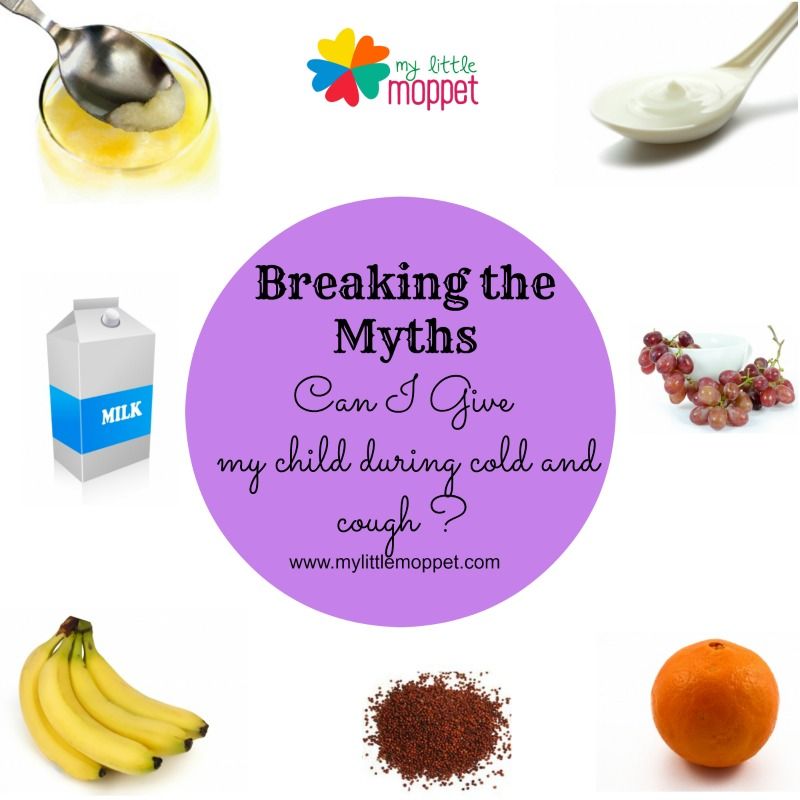
Offer your child a variety of foods and let them choose for themselves. Children love to eat on their own, so if possible, offer food that the child can eat with their hands. nine0003
It is important to remember that a baby can choke on pieces of food, so whatever you give your baby should be crushed or cut into small pieces that can be easily chewed.
Do not give to a small child: nuts, whole grapes, cherry tomatoes (unless quartered), whole carrots, seeds (such as pumpkin or sunflower seeds), round candies, legumes, raisins, because a child can eat them choke.
Also in the diet of children of the first 3 years of life should not be present:
Mushrooms; canned snacks, pickled vegetables and fruits
Home canned food
Dry concentrates for side dishes
Hot sauces, mustard, horseradish, pepper, vinegar, mayonnaise
Natural coffee
Juices and drinks in the form of dry concentrates; sweet carbonated drinks
Products containing food additives (flavorings, dyes of artificial origin, including chewing gum), popcorn
Combined fats; cakes and pastries
It is important to remember that children of this age should not be given too spicy and spicy foods.
How to properly feed your baby
Elena Gvozdetskaya
Pediatric GMS Clinic
Ask two mothers how to properly feed a baby and you will get two different answers. This is indeed a delicate and difficult issue. But let's look into it together with expert pediatrician GMS Clinic Elena Gvozdetskaya. The doctor spoke about the principles of nutrition for babies, gave recommendations on the choice of products, the method of preparation, and much more. nine0003
What are the 3 main principles of feeding children
- Safety.
- Variety.
- Regularity.
Does the number of feeds depend on the child's age?
Yes, it depends. The younger the child, the more meals should be. After all, the small stomachs of children cannot digest a lot of food at a time. For example, babies are fed every 3-4 hours, and preschoolers - 3 to 5 times a day.
A young child's serving size can be measured with their fists. He should eat 12 such "cams" of food, of which 2-3 are main meals, 1-2 are snacks. Plus, there should be 2-3 servings of dairy products per day. nine0003
He should eat 12 such "cams" of food, of which 2-3 are main meals, 1-2 are snacks. Plus, there should be 2-3 servings of dairy products per day. nine0003
Why do you need breakfast, lunch and dinner?
Food is a source of energy and nutrients. It must be done regularly so that the baby is active, grows and develops properly. Complete breakfasts, lunches and dinners are the key to children's health.
Also, thanks to the diet, you can think over the diet for the day so that the child receives the required amount of calories from healthy food. Parents often plan in advance what meals to cook as main meals. nine0003
Is it okay to have snacks between main meals?
Yes, it is necessary. Long breaks between meals can lead to fatigue, fatigue, low blood sugar and concentration, memory.
It is important that snacks include healthy foods such as vegetables, fruits, grains or protein. For example, you can make dried fruit bars, sandwiches with bread and eggs.
Is it necessary to give porridge for breakfast? Which are the best to choose? nine0066
No, not required. Porridge can be replaced with sugar-free cereal or a sandwich made from whole grain bread. During the day, the child should eat 5-6 "cams" of cereals.
You can choose any porridge for breakfast: oatmeal, rice, buckwheat, corn, millet. Be sure to cut out sugar. Instead, fruits, dried fruits are added to some dishes, and honey can be given to children over 1 year old.
How to replace porridge for breakfast to diversify the diet?
Any useful product will do. The main thing is that the first meal gives satiety for at least 2.5 hours - before a snack. Breakfast usually includes: nine0003
- cereals: porridge, cereals, muesli, granola, healthy baked goods;
- protein: scrambled eggs, meat, fish;
- dairy products: yogurt, milk, cheese, syrniki;
- vegetables or fruits.
These products can be combined in various ways. For example, this morning offer your child cheesecakes with strawberries, and tomorrow - an omelet with whole grain bread and cheese.
For example, this morning offer your child cheesecakes with strawberries, and tomorrow - an omelet with whole grain bread and cheese.
Remember that according to statistics, children who do not eat breakfast eat sweets more often and drink carbonated drinks. Because of this, they have an increased risk of obesity, the development of cardiovascular diseases and caries. nine0003
Does a child really need soups?
Actually, no. Some parents often prepare soup for their children because it is easier for babies to chew and it passes through the esophagus to the stomach faster. After all, there is already liquid in the dish. This is more convenient than chewing dry food for a long time and carefully so that the required amount of saliva is released.
Soup is water, vegetables and meat. It will be just as helpful if the child eats them simply sliced, chewed thoroughly, and drinks enough liquid throughout the day. The main thing is to make sure that the meal includes different food groups.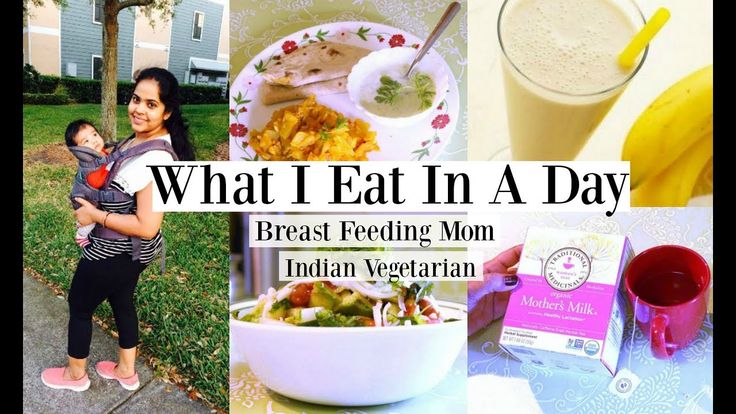 It doesn't matter if it's borscht or vinaigrette. nine0003
It doesn't matter if it's borscht or vinaigrette. nine0003
What is the ideal dinner for a child?
The main thing is that the child does not experience hunger at night. So choose foods that saturate well. For example:
- cereals: buckwheat, rice, bulgur;
- proteins: chicken, turkey;
- vegetables.
For example, buckwheat with boiled turkey and broccoli is a great dinner option. Or bulgur with steamed chicken cutlets and cucumber and tomato salad.
Toddlers can have a second dinner 20-30 minutes before bedtime. Choose foods such as kefir, yogurt or some kind of fruit. Just don't forget to brush your child's teeth afterwards. nine0003
Do kids only need freshly prepared food, or is yesterday's soup okay too?
Food that has been stored for more than two hours at 6 to 8 °C is no longer safe for the baby. We do not recommend giving it, because pathogenic bacteria begin to multiply there and toxins are released. If you want to store the dish for about two days, you need rapid cooling to 6 degrees and below.
If you want to store the dish for about two days, you need rapid cooling to 6 degrees and below.
How to prepare food?
The best methods are steaming or boiling. The latter is considered the best option for killing harmful bacteria because the entire surface of the product is in hot water. And steaming preserves the maximum of vitamins. nine0003
Food can also be baked and fried, but with a little oil. But the formation of a black crust should not be allowed - the rarer the dishes of this method of preparation in the child's diet, the better.
What kind of meat and fish to choose for children?
Our recommendation:
- red meat - 1 portion three times a week: beef, pork, lamb;
- white meat - 1 serving per day: chicken, turkey, rabbit;
- fish - 2 times a week: hake, cod, perch, red fish. nine0069
Please note! Do not give your child the meat of large predatory fish, such as shark, tuna. After all, they can accumulate mercury and other harmful substances.
What is the norm of fruits and vegetables for a child per day?
Recommended for young children: 2-3 "fist" fruits and vegetables per day. Remember that dried fruits and baked foods also count.
Cooked vegetables, fruit purees and some raw fruits, such as avocado, mango, peach, banana, can be given at the start of complementary foods. After a year, we recommend starting to introduce soft-skinned fruits into the diet - this is good for digestion. nine0003
Milk in the diet of children - for or against?
If the child is not lactose intolerant or allergic to cow's milk protein, he can drink it and eat dairy products.
When parents notice that their children are consuming too much of this micronutrient-rich drink, it is important to find the cause. Perhaps the baby is not enough from the diet of any substances. Offer a healthy substitute - you need the child to eat a variety of foods and get the whole set of nutrients from different foods. nine0003
nine0003
What drinks are good for babies and schoolchildren?
Prefer the following drinks:
- pure water;
- mors;
- compote;
- small amount natural juice or smoothie;
- fermented milk drinks;
- milk.
All of these drinks should be free of sugar. When buying in a store, read the ingredients, even if it says "specially for children." nine0003
Do not give children the following:
- sugary drinks (packaged juices, sodas) up to 3 years;
- tea, coffee, other caffeinated drinks up to 5 years;
- healing mineral water.
There are special children's teas, often containing sugar and herbal extracts. Therefore, we do not recommend giving them to a baby until he is 2 years old. Keep in mind that herbal drinks can cause an allergic reaction and reduce iron absorption, and are also not recommended for babies under 2 years of age. nine0003
At what age can sweets be given to children? What exactly?
Follow these guidelines:
- no added sugar until two years of age;
- from 2 to 4 years, sweets may be limited;
- Ages 5 to 7 - 3-4 teaspoons of sugar per day is acceptable, including candy, cookies, sugary cereals, juices.
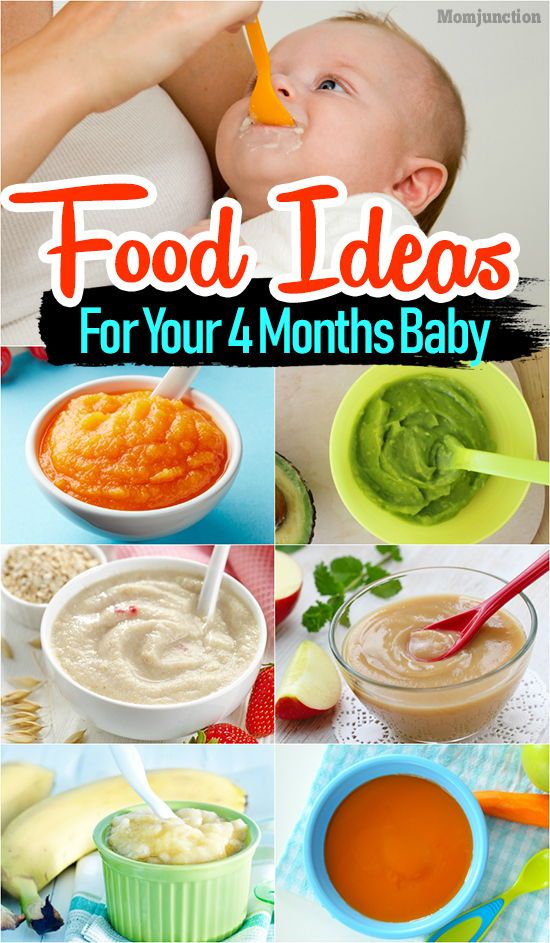
From the age of 5, all sweets can be given in moderation, such as marshmallows, marmalade, marshmallows, ice cream, cereal bars, chocolate. nine0003
What causes dry food in children?
Poorly chewed dry dense food moves worse through the esophagus, takes longer to digest, creates discomfort in the stomach and a feeling of "lump". It's not harmful, but it's uncomfortable. To avoid this, it is enough to chew food thoroughly and drink liquids throughout the day.
At what age can children be transferred to a common table?
Usually a child already eats pieces of most complementary foods at the age of one, from this age it is possible to eat one meal with everyone. nine0003
It is only important to adapt the baby plate:
- make meals without salt, salt separately for adults;
- cook until completely fried or boiled, raw should not be given;
- lettuce can be cut into small pieces: the baby should chew the pieces one at a time, adults should season with sauces in a separate plate;
- the child's meat must be divided into fibers;
- meatballs and cutlets - finely chop for children, pour the sauce separately for adults (the same with pasta and cereals).












